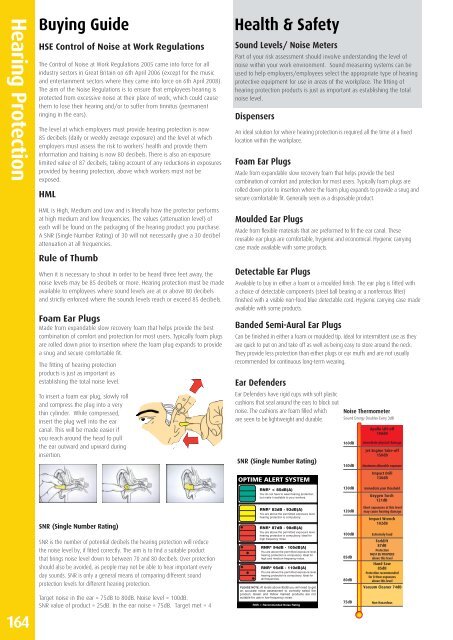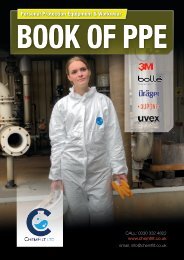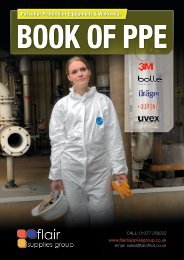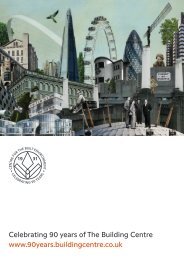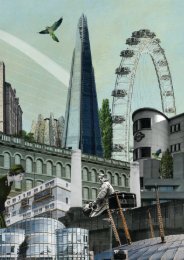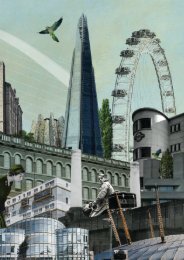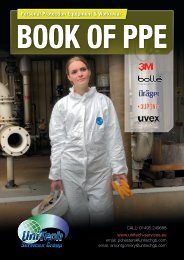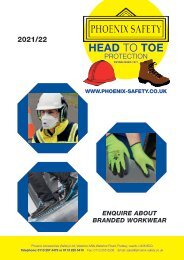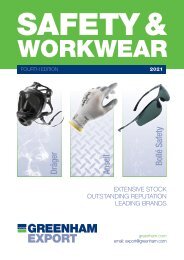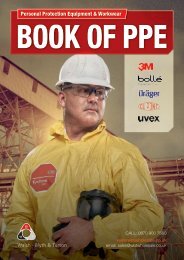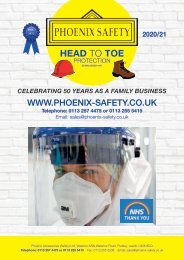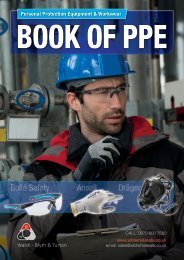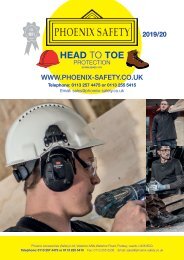Phoenix PPE Catalogue
Phoenix PPE Catalogue
Phoenix PPE Catalogue
Create successful ePaper yourself
Turn your PDF publications into a flip-book with our unique Google optimized e-Paper software.
Hearing Protection<br />
Buying Guide<br />
HSE Control of Noise at Work Regulations<br />
The Control of Noise at Work Regulations 2005 came into force for all<br />
industry sectors in Great Britain on 6th April 2006 (except for the music<br />
and entertainment sectors where they came into force on 6th April 2008).<br />
The aim of the Noise Regulations is to ensure that employees hearing is<br />
protected from excessive noise at their place of work, which could cause<br />
them to lose their hearing and/or to suffer from tinnitus (permanent<br />
ringing in the ears).<br />
The level at which employers must provide hearing protection is now<br />
85 decibels (daily or weekly average exposure) and the level at which<br />
employers must assess the risk to workers’ health and provide them<br />
information and training is now 80 decibels. There is also an exposure<br />
limited value of 87 decibels, taking account of any reductions in exposures<br />
provided by hearing protection, above which workers must not be<br />
exposed.<br />
HML<br />
Health & Safety<br />
Sound Levels/ Noise Meters<br />
Part of your risk assessment should involve understanding the level of<br />
noise within your work environment. Sound measuring systems can be<br />
used to help employers/employees select the appropriate type of hearing<br />
protective equipment for use in areas of the workplace. The fitting of<br />
hearing protection products is just as important as establishing the total<br />
noise level.<br />
Dispensers<br />
An ideal solution for where hearing protection is required all the time at a fixed<br />
location within the workplace.<br />
Foam Ear Plugs<br />
Made from expandable slow recovery foam that helps provide the best<br />
combination of comfort and protection for most users. Typically foam plugs are<br />
rolled down prior to insertion where the foam plug expands to provide a snug and<br />
secure comfortable fit. Generally seen as a disposable product.<br />
164<br />
164<br />
HML is High, Medium and Low and is literally how the protector performs<br />
at high medium and low frequencies. The values (attenuation level) of<br />
each will be found on the packaging of the hearing product you purchase.<br />
A SNR (Single Number Rating) of 30 will not necessarily give a 30 decibel<br />
attenuation at all frequencies.<br />
Rule of Thumb<br />
When it is necessary to shout in order to be heard three feet away, the<br />
noise levels may be 85 decibels or more. Hearing protection must be made<br />
available to employees where sound levels are at or above 80 decibels<br />
and strictly enforced where the sounds levels reach or exceed 85 decibels.<br />
Foam Ear Plugs<br />
Made from expandable slow recovery foam that helps provide the best<br />
combination of comfort and protection for most users. Typically foam plugs<br />
are rolled down prior to insertion where the foam plug expands to provide<br />
a snug and secure comfortable fit.<br />
The fitting of hearing protection<br />
products is just as important as<br />
establishing the total noise level.<br />
To insert a foam ear plug, slowly roll<br />
and compress the plug into a very<br />
thin cylinder. While compressed,<br />
insert the plug well into the ear<br />
canal. This will be made easier if<br />
you reach around the head to pull<br />
the ear outward and upward during<br />
insertion.<br />
SNR (Single Number Rating)<br />
SNR is the number of potential decibels the hearing<br />
OPTIME<br />
protection will<br />
ALERT<br />
reduce<br />
SYSTEM<br />
the noise level by, if fitted correctly. The aim is to find a suitable product<br />
that brings noise level down to between 70 and 80 decibels. Over protection<br />
should also be avoided, as people may not be able to hear important every<br />
day sounds. SNR is only a general means of comparing different sound<br />
protection levels for different hearing protection.<br />
Target noise in the ear = 75dB to 80dB. Noise level = 100dB.<br />
SNR value of product = 25dB. In the ear noise = 75dB. Target met = 4<br />
Moulded Ear Plugs<br />
Made from flexible materials that are preformed to fit the ear canal. These<br />
reusable ear plugs are comfortable, hygienic and economical. Hygienic carrying<br />
case made available with some products.<br />
Detectable Ear Plugs<br />
Available to buy in either a foam or a moulded finish. The ear plug is fitted with<br />
a choice of detectable components (steel ball bearing or a nonferrous filter)<br />
finished with a visible non-food blue detectable cord. Hygienic carrying case made<br />
available with some products.<br />
Banded Semi-Aural Ear Plugs<br />
Can be finished in either a foam or moulded tip. Ideal for intermittent use as they<br />
are quick to put on and take off as well as being easy to store around the neck.<br />
They provide less protection than either plugs or ear muffs and are not usually<br />
recommended for continuous long-term wearing.<br />
Ear Defenders<br />
Ear Defenders have rigid cups with soft plastic<br />
cushions that seal around the ears to block out<br />
noise. The cushions are foam filled which<br />
are seen to be lightweight and durable.<br />
SNR (Single Number Rating)<br />
OPTIME ALERT SYSTEM<br />
RNR* < 85dB(A)<br />
You do not have to wear hearing protection,<br />
but make it available to your workers.<br />
Noise Thermometer<br />
Sound Energy Doubles Every 3dB<br />
RNR* 130dB94dB Immediate - 105dB(A) pain threshold<br />
You are above the permitted exposure level,<br />
hearing protection is compulsory. Oxygen Ideal Torch for<br />
high and medium frequency noise. 121dB<br />
Short exposures at this level<br />
RNR* 83dB - 93dB(A)<br />
RNR* 95dB - 110dB(A)<br />
120dB may cause hearing damage<br />
You are above the permitted exposure level,<br />
You are above the permitted exposure level,<br />
hearing protection is compulsory.<br />
hearing protection is compulsory. Ideal for<br />
all frequencies. Impact Wrench<br />
102dB<br />
RNR* 87dB - 98dB(A)<br />
PLEASE NOTE: At levels above 95dB you will need to get<br />
You are above the permitted exposure level, an accurate noise assessment to correctly select the<br />
hearing protection is compulsory. Ideal for product. Green and 100dB Yellow marked products Extremely are loud not<br />
high frequency noise.<br />
suitable for use in low frequency noise.<br />
OPTIME ALERT SYSTEM<br />
Forklift<br />
RNR = Recommended Noise Rating<br />
87dB<br />
RNR* < 85dB(A) RNR* < 85dB(A)<br />
RNR* 94dB - 105dB(A) RNR* 94dB - 105dB(A)<br />
You are above the permitted exposure You are above level, the permitted exposure level,<br />
Protection<br />
You do not have to wear hearing You protection, do not have to wear hearing protection,<br />
hearing protection is compulsory. hearing Ideal protection for is compulsory. Ideal for<br />
MUST BE PROVIDED<br />
but make it available to your workers. but make it available to your workers.<br />
high and medium frequency noise. high and medium frequency noise. 85dB<br />
above this level<br />
Hand Saw<br />
RNR* 83dB - 93dB(A) RNR* 83dB - 93dB(A) RNR* 95dB - 110dB(A) RNR* 95dB - 110dB(A)<br />
85dB<br />
You are above the permitted exposure You are above level, the permitted exposure You are level, above the permitted exposure You are above level, the permitted exposure level, Protection recommended<br />
hearing protection is compulsory. hearing protection is compulsory. hearing protection is compulsory. hearing Ideal protection for is compulsory. Ideal for<br />
for 8-Hour exposures<br />
all frequencies.<br />
all frequencies.<br />
80dB<br />
above this level<br />
RNR* 87dB - 98dB(A) RNR* 87dB PLEASE - 98dB(A) NOTE: At levels above PLEASE 95dB you NOTE: will At need levels to above get 95dB you will need to get Vacuum Cleaner 74dB<br />
You are above the permitted exposure You are above level, the an permitted accurate exposure noise assessment level, an accurate to correctly noise select assessment the to correctly select the<br />
hearing protection is compulsory. hearing Ideal protection for product. is compulsory. Green Ideal and for Yellow product. marked Green products and are Yellow not marked products are not<br />
high frequency noise. high frequency noise. suitable for use in low frequency suitable noise. for use in low frequency noise.<br />
75dB<br />
Non-Hazardous<br />
RNR = Recommended Noise RNR Rating = Recommended Noise Rating<br />
160dB<br />
140dB<br />
Apollo Lift-off<br />
188dB<br />
Immediate physical damage<br />
Jet Engine Take-off<br />
150dB<br />
Maximum allowable exposure<br />
Impact Drill<br />
130dB


